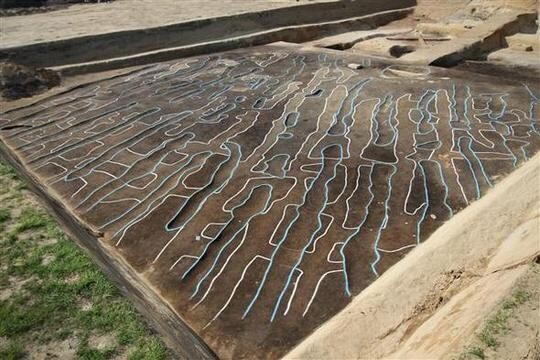hankyoreh
Links to other country sites 다른 나라 사이트 링크
East Asia’s oldest farmland discovered in Korea

By Roh Hyung-suk, culture correspondent
The ruins of East Asia’s oldest farmland, where Neolithic farmers planted crops five thousand years ago, have been discovered on the East Sea coast of Gangwon.
The National Research Institute of Cultural Heritage unveiled the recently unearthed remains June 26 in a briefing at a Neolithic site (Historic Site No. 426) in the village of Munam, Goseong County. Estimated to be from the middle Neolithic period some time around 3000 BCE, the ruins are from the first confirmed Neolithic farmland in Korea, China, or Japan.
The discovery is being taken as concrete evidence of farming on the Korean Peninsula during the era. Scholars generally believed farming began in earnest during the Bronze Age (1500 BCE--400 CE), when the earliest previously known farmland ruins in Korea originated.
Found in a sand field near the East Sea coast, the ruins consist of upper and lower strata. The upper level has the typical furrowed structure, although the width of the embankment and furrows is not fixed. The lower stratum is also irregular, with winding and angled furrows. Judging from this, the institute said it is possible to ascertain that the farmland dates to before the Bronze Age, when field shapes were standardized.
The institute added that supporting evidence for this conclusion included Neolithic relics unearthed near the lower stratum, including earthenware fragment with a slash pattern, stone arrowheads, and carbonized millet, as well as house lots from the same era dug into the lower stratum’s field layer.
Settled agriculture is believed to have begun in the Neolithic period. Evidence has been found in early Neolithic ruins in the Middle and Near East and Europe, but no direct traces of rice fields have been found in East Asia, leading to an ongoing debate over the period when farming first began there.
Indeed, the oldest known rice fields found in Korea to date are from the Bronze Age, in Ulsan’s Mugeo neighborhood and Jinju‘s Daepyeong village. Carbonized rice grains from the same era were also unearthed in the village of Heunam in Gyeonggi’s Yeoju County.
But some scholars have recently come out with evidence suggesting that the timeline should be pushed back to the Neolithic period. Last year, Busan’s Bokcheon Museum announced that it had found traces of proso and millet marked onto earthenware excavated from Neolithic shell mounds in the city’s Dongsam neighborhood.
Curator and excavator staff member Hong Hyeon-u explained, “The conversation in academia so far was at the stage of conjecturing the possibility of Neolithic farming based on things like traces of grains on earthenware and stoneware that appeared to be for farming.”
“With this discovery, we are now able to support the conjecture,” he added.
Please direct questions or comments to [english@hani.co.kr]
Editorial・opinion
![[Column] Season 2 of special prosecutor probe may be coming to Korea soon [Column] Season 2 of special prosecutor probe may be coming to Korea soon](https://flexible.img.hani.co.kr/flexible/normal/500/300/imgdb/original/2024/0426/3317141030699447.jpg) [Column] Season 2 of special prosecutor probe may be coming to Korea soon
[Column] Season 2 of special prosecutor probe may be coming to Korea soon![[Column] Park Geun-hye déjà vu in Yoon Suk-yeol [Column] Park Geun-hye déjà vu in Yoon Suk-yeol](https://flexible.img.hani.co.kr/flexible/normal/500/300/imgdb/original/2024/0424/651713945113788.jpg) [Column] Park Geun-hye déjà vu in Yoon Suk-yeol
[Column] Park Geun-hye déjà vu in Yoon Suk-yeol- [Editorial] New weight of N. Korea’s nuclear threats makes dialogue all the more urgent
- [Guest essay] The real reason Korea’s new right wants to dub Rhee a founding father
- [Column] ‘Choson’: Is it time we start referring to N. Korea in its own terms?
- [Editorial] Japan’s rewriting of history with Korea has gone too far
- [Column] The president’s questionable capacity for dialogue
- [Column] Are chaebol firms just pizza pies for families to divvy up as they please?
- [Column] Has Korea, too, crossed the Rubicon on China?
- [Correspondent’s column] In Japan’s alliance with US, echoes of its past alliances with UK
Most viewed articles
- 1‘We must say no’: Seoul defense chief on Korean, USFK involvement in hypothetical Taiwan crisis
- 2[Editorial] Korea’s surprise Q1 growth requires objective assessment, not blind fanfare
- 3[Column] Season 2 of special prosecutor probe may be coming to Korea soon
- 4Division commander ordered troops to enter raging flood waters before Marine died, survivor says
- 5Is Japan about to snatch control of Line messenger from Korea’s Naver?
- 6[Column] ‘Choson’: Is it time we start referring to N. Korea in its own terms?
- 7[Special report- Part III] Curses, verbal abuse, and impossible quotas
- 8Why Korea shouldn’t welcome Japan’s newly beefed up defense cooperation with US
- 9S. Korea “monitoring developments” after report of secret Chinese police station in Seoul
- 10The dream K-drama boyfriend stealing hearts and screens in Japan